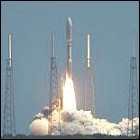 NASA launches the unmanned Juno space probe on its way to Jupiter, on a trajectory that will accelerate the vehicle through a series of maneuvers, including a gravity assist pass of Earth, en route to Jupiter. Once it arrives at the solar system’s largest planet, Juno will enter a polar orbit to monitor the planet’s clouds and magnetic field over a period of one year beginning in 2016. Juno is solar-powered, without the customary nuclear power source that has been a feature of all previous outer solar system missions. Since it will spend time within the heaviest area of Jupiter’s magnetosphere, Juno’s components are built into a hexagonal structure which acts as a heavy-duty Faraday cage to block out the radiation trapped within Jupiter’s magnetic field.
NASA launches the unmanned Juno space probe on its way to Jupiter, on a trajectory that will accelerate the vehicle through a series of maneuvers, including a gravity assist pass of Earth, en route to Jupiter. Once it arrives at the solar system’s largest planet, Juno will enter a polar orbit to monitor the planet’s clouds and magnetic field over a period of one year beginning in 2016. Juno is solar-powered, without the customary nuclear power source that has been a feature of all previous outer solar system missions. Since it will spend time within the heaviest area of Jupiter’s magnetosphere, Juno’s components are built into a hexagonal structure which acts as a heavy-duty Faraday cage to block out the radiation trapped within Jupiter’s magnetic field.
Tags:
Categories
Comments are closed